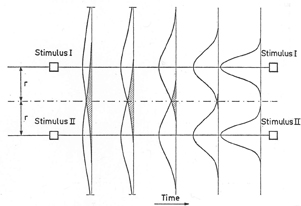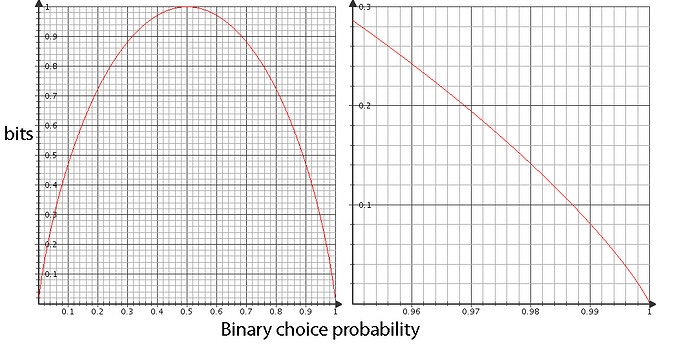[From Bill Powers (2009.03.11.0745)]
I’m supposed to go to a conference at Pam Fox’s “Hotel Villa
Nirvana” with some others from IAACT on Monday. At the moment I’m on
antibiotics for a nasty bronchitis thing and don’t know if I’m up to the
trip. This sounds like a blog, but stay tuned.
Martin Taylor 2009.03.08.14.39 –
I’m interested in more than just
the search for the controlled variable. I want to know something about
the properties of the control loops, and in particular the properties of
their component pathways. That’s one reason for continuing to concentrate
on the Schouten experiment. I’ll use conventional research when it seems
to have something useful to say, which I think is the case more often
than you think is the case.
I think that’s a reasonable objective (in case anyone asks what I think
is reasonable). Just to stick with the basic PCT methodology, however, I
think that the first step in any such investigation is to establish
beyond a resonable doubt what it is that you’re investigating. Exactly
what are the control loops involved in the Schouten experiment? The
evidence on that score is pretty sparse, since no attempt was (or could
have been) made to identify the controlled variable, the means of sensing
it, and the means of affecting it. Before you can measure the properties
of a control loop, or convince anyone that that’s what you’re measuring,
you must identify the control loop with whatever tests are appropriate. I
don’t care whether you call the approach the Test for the Controlled
Variable, but to preserve the chain of evidence, so to speak, you have to
provide some formal reason to suppose that the control system has been
identified as far as possible. It’s easy to investigate the properties of
phlogiston if you don’t have to demonstrate that there’s such a thing as
phlogiston. I don’t want other scientists to think of PCT as
phlogiston.
In the opposite direction, PCT
ought to be able to say something useful about most observations of the
behaviour of a person, no matter how the data were collected – by casual
observation, conventional experiment, or experiment based on PCT
analysis.
I really don’t agree with that. There are certain things you need to know
before you’re justified in saying anything about human control systems.
At least you need to know what the behavior is controlling, and to find
that out you have to do things that aren’t ordinarily done in an
experiment designed under a different theory. For example, I suspect that
in an operant-conditioning experiment, what is being controlled by the
subject organism is some aspect of the reinforcer delivered by pressing a
lever, or some effect of doing that. The simplest way to rule out that
possibility is to apply a disturbance directly to the variable being
controlled, as you define it. If the effect is exactly what you would
predict from knowing the disturbance, and if nothing the subject does
tends to reduce that effect rather strongly, you can give up that
hypothesis without any strain. If that test is passed, you can go on to
identify the particular inputs and outputs that go in and out of the
hypothesized control system, or if you have a publication deadline you
can assume with at least some confidence that there’s a control system
involved somehow, somewhere. But who would think of adding and
subtracting food from the cup that is normally filled by the rat’s
pressings of a lever? (fortunately, some people studying obesity did that
with animals who fed themselves entirely by pressing the bar, with the
results we would expect);
In fact, Bruce Abbott found that our initial assumptions about a rat’s
control systems were wrong: by subtracting out the feeding time from the
total experimental time, Bruce showed that the rats did NOT vary their
rate of bar-pressing as the rate of reinforcement changed. They
apparently just pressed as fast as they could or else didn’t press at
all. We would have looked pretty silly if we had reported our results
before realizing that. Later we realized that the standard method of
maintaining body weight at 80% of the free-feeding level was an
experimenter-driven control process that competed with the rats’ own
control systems, if any, so we were preventing any normal control process
in the rats based on body weight from working.
The main thing I don’t recommend is actually a very bad habit
psychologists often get into: making a fundamental assumption, and then
simply proceeding as if it’s right without pausing for any kind of test.
One particularly bad example was something I read in Carver &
Scheier. They were looking for some effect of self-awareness on something
or other. What they did to manipulate self-awareness was to place a
mirror in the same room with the subject. This is the same principle used
in designing the Three Mile Island reactor controls: measure the command
that was supposed to open or close a cooling-water valve, instead of
verifying the effect on water flow. Does placing a mirror in a room
increase the self-awareness of a subject in the same room? Maybe. Maybe
not. Since we have no way to detect self-awareness itself, there is no
way to test this assumption. Of course that renders the rest of the
experiment as useless as the critical light on the panel of indicators at
Three Mile Island, which showed only that a switch was in the
“on” position. So there was a mirror in the room when the
person did something. So what?
If S-R psychologists had been required to demonstrate that everything
called a “response” was a response to a specific stimulus
as predicted by S-R theory, S-R psychology wouldn’t have lasted
long.
The question really is
whether any particular researcher wants to consider particular aspects
either of data or of mechanism. And that’s a question of the particular
researcher’s reference values for controlled perceptions, something that
can be influenced by, but not easily controlled by other
people.
I think that in any scientific culture, we place requirements on each
other to build our ideas on firm foundations, not just on assumptions.
People can differ on what they call a firm foundation, but I don’t think
that any scientific journal worthy of that name would accept a paper in
which the primary facts needed to support the conclusions were simply
made up by the author. It’s not just a matter of personal preferences and
academic freedom. Think of the 150 years science wasted on phlogiston,
just because nobody asked how we could find out if it really
existed.
I have no objection to measuring the properties of control systems to any
depth one finds interesting. But I’m not going to believe a word of it if
you don’t first show that you’re actually studying a control process. We
have to prove that we studying something every time we study it, or the
results are simply worthless. It really doesn’t take that long to check
out a few assumptions. A chemist doesn’t simply assume that his measuring
scales are calibrated right, or that the liquid in a bottle is really
sulphuric acid. We learn mainly from the times when the assumptions
prove, to our surprise and edification, to be wrong – but that will
never happen if we don’t test them.
Best,
Bill P.

